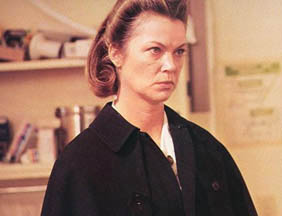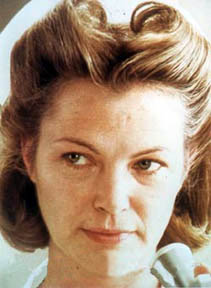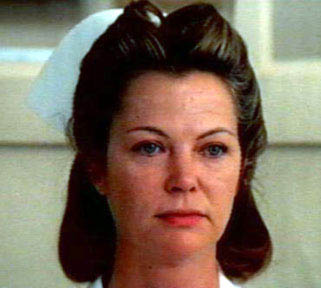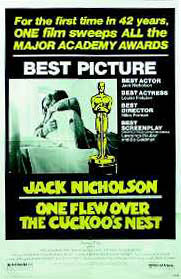
ONE FLEW OVER THE CUCKOO'S NEST


ONE FLEW OVER THE CUCKOO'S NEST

 One Flew Over the Cuckoo's Nest (1975) -- Smashingly effective version of Ken Kesey's novel about a rebel outcast, McMurphy (Jack Nicholson), who is locked in a hospital for the insane. The book was a lyric jag, and it became a nonconformists' bible. Published in 1962, it contained the prophetic essence of the whole Vietnam period of revolutionary politics going psychidelic. Milos Forman, who directed the movie version, must have understood how crude the poetic-paranoid vision of the book would look on the screen after the 60s paranoia had lost its nightmarish buoyancy, and he and the scenarists -- Lawrence Hauben, and then Bo Goldman -- did an intelligent job of loosening Kesey's schematism.
One Flew Over the Cuckoo's Nest (1975) -- Smashingly effective version of Ken Kesey's novel about a rebel outcast, McMurphy (Jack Nicholson), who is locked in a hospital for the insane. The book was a lyric jag, and it became a nonconformists' bible. Published in 1962, it contained the prophetic essence of the whole Vietnam period of revolutionary politics going psychidelic. Milos Forman, who directed the movie version, must have understood how crude the poetic-paranoid vision of the book would look on the screen after the 60s paranoia had lost its nightmarish buoyancy, and he and the scenarists -- Lawrence Hauben, and then Bo Goldman -- did an intelligent job of loosening Kesey's schematism.
Set in 1963, the movie retains most of Kesey's ideas but doesn't diagram them the way the book does. We're not cued at every step, and the end isn't so predictable. (On the shock table, McMurphy doesn't ask, "Do I get a crown of thorns?" -- as he did in the book.) Milos Forman appears to have recognized the strong realistic material within Kesey's conception. We all fear being locked up among the insane, helpless to prove our sanity, perhaps being driven mad; this fear is almost as basic as that of being buried alive. And we can't formulate a clear-cut difference between sane and insane. So Forman replaces the novel's trippy subjectivity with a more realistic view of the patients which leaves their mental condition ambiguous. They seem not much more insane than the nurses, the doctors, the attendants. They're cowards, terrified of Big Nurse (Louise Fletcher), but then the staff is intimidated by her, too.
 What has disappeared from the film version is the Combine (to be known a little while after the book came out as the Establishment). Forman could have exploited the Watergate hangover and retained the paranoid simplicities that helped make hits of Easy Rider and Joe, but instead he (with, it appears, the support of his producers, Saul Zaentz, of Fantasy Records, and Michael Douglas) has taken a less romantic, more suggestive approach. McMurphy's sanity isn't so clear-cut, and he doesn't give his buddies the courage to go back out into the world; the ward isn't emptied, as it is in the book. (Now only the Indian walks out.) Cut off from the concept of the Combine, the ward symbolizes the pressures and ambiguities of society as we know it, and the movie comes at a time when we're all prepared to accept a loony bin as the right metaphor for the human condition.
What has disappeared from the film version is the Combine (to be known a little while after the book came out as the Establishment). Forman could have exploited the Watergate hangover and retained the paranoid simplicities that helped make hits of Easy Rider and Joe, but instead he (with, it appears, the support of his producers, Saul Zaentz, of Fantasy Records, and Michael Douglas) has taken a less romantic, more suggestive approach. McMurphy's sanity isn't so clear-cut, and he doesn't give his buddies the courage to go back out into the world; the ward isn't emptied, as it is in the book. (Now only the Indian walks out.) Cut off from the concept of the Combine, the ward symbolizes the pressures and ambiguities of society as we know it, and the movie comes at a time when we're all prepared to accept a loony bin as the right metaphor for the human condition.
But this leaves a problem that isn't completely solved: Big Nurse. Instead of the giant-breasted terror of the novel, Louise Fletcher's Nurse Ratched resembles Shirley Temple Black. She's the smiling, well-organized institutional type -- the dean of women who was was disappointed in you, the phone-company supervisor who tells you why she has to interrupt your service for non-payment. Nurse Ratched's soft, controlled voice and girlishly antiseptic manner always put you in the wrong; you can't cut through the crap in her -- it goes too deep. And she's too smart for you; she's got all the protocol in the world on her side.
 In Thieves Like Us, Louise Fletcher played Mattie, the strong, no-nonsense betrayer. Here, thinner and almost baby-faced, she's a middle-aged woman wearing her hair in a forties wartime style and still seeing herself as an ingenue. Louise Fletcher gives a masterly performance. Changes in her flesh tone tell us what Nurse Ratched feels. We can see the virginal expectancy -- the purity -- that has turned into puffy-eyed self-righteousness. She thinks she's doing good for people, and she's hurt -- she feels abused -- if her authority is questioned; her mouth gives way and the lower part of her face sags. She's not the big white mother that she is in the book; that part of the symbolism has been stripped away. She's the company woman incarnate; the only way to reach her is to go for her throat -- though neither the novel nor the film perceives that women, too, would want to strangle her.
In Thieves Like Us, Louise Fletcher played Mattie, the strong, no-nonsense betrayer. Here, thinner and almost baby-faced, she's a middle-aged woman wearing her hair in a forties wartime style and still seeing herself as an ingenue. Louise Fletcher gives a masterly performance. Changes in her flesh tone tell us what Nurse Ratched feels. We can see the virginal expectancy -- the purity -- that has turned into puffy-eyed self-righteousness. She thinks she's doing good for people, and she's hurt -- she feels abused -- if her authority is questioned; her mouth gives way and the lower part of her face sags. She's not the big white mother that she is in the book; that part of the symbolism has been stripped away. She's the company woman incarnate; the only way to reach her is to go for her throat -- though neither the novel nor the film perceives that women, too, would want to strangle her.
Forman isn't a manhood-and-size obsessive like Kesey, but the film's plot structure derives from Kesey's male-female symbolism, and when that is somewhat demythified, the plot goes a little out of kilter, into melodrama. Those who know the book will probably feel that Nurse Ratched is now more human, but those who haven't read it may be appalled at her inhumanity. The melodramatics are flagrant in the episode involving Billy Bibbit (Brad Dourif), the stuttering, mother-fixated virgin of the ward. McMurphy fixes him up with his own hooker girlfriend Candy (Marya Small), and the next morning Billy is cured of his stutter -- until Nurse Ratched tells him that she is going to inform his mother of what he's done. Then the stutter comes back. Brad Dourif gives the rolea fey spark, but without Kesey's giddy pop view this crybaby-juvenile bit is a bummer -- psychiatric dramaturgy circa Lon McCallister and, before him, Eric Linden.
Will Sampson, a towering full-blooded Creek, is very impressive as Chief Broom, the resurrected catatonic. Forman's tentative, literal-minded direction lacks the excitement of movie art and there's a callousness running through his work; he gets laughs by pretending that mental disturbance is the same thing as ineptitude. But the story and the acting make the film emotionally powerful. And Nicholson, looking punchy, tired, and baffled -- and not on top of his character (as he often is) -- lets you see into him, rather than controlling what he lets you see. With William Redfield, Scatman Crothers, Danny DeVito, Vincent Schiavelli, Sydney Lassick, Louisa Moritz, and Christopher Lloyd; cinematography by Haskell Wexler. Academy Awards: Best Picture, Director, Actor (Nicholson), Actress (Fletcher), Screenplay (Hauben and Goldman), Released by United Artists.

CLICK HERE FOR LOUISE FLETCHER IN ONE FLEW OVER THE CUCKOO'S NEST
CLICK HERE FOR PAULINE KAEL ON ONE FLEW OVER THE CUCKOO'S NEST
CLICK HERE FOR MORE PHOTOS FROM ONE FLEW OVER THE CUCKOO'S NEST
CLICK HERE FOR ART FROM ONE FLEW OVER THE CUCKOO'S NEST
CLICK HERE FOR NURSE RATCHED IN WAX FROM ONE FLEW OVER THE CUCKOO'S NEST
CLICK HERE FOR EXCERPTS FROM MAD MAGAZINE'S CUCKOO'S NEST PARODY
CLICK HERE FOR THE NEW YORK TIMES ON CUCKOO'S NEST AT 25
CLICK HERE FOR ENTERTAINMENT WEEKLY ON CUCKOO'S NEST'S OSCAR SILVER ANNIVERSARY
MAIN
CONTENTS
FAQ
RESUME
PHOTOS
DS9
CONS
ART
BOOKS
LINKS
